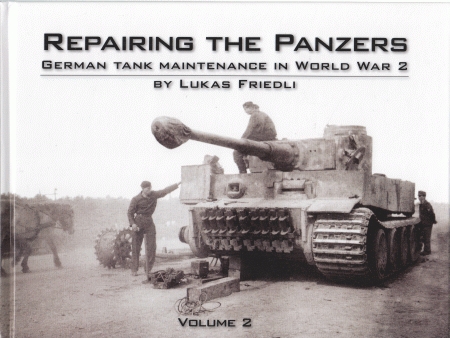- Author: Lukas Friedli
- Hardback
- ISBN: 978-1-908032-01-0
Review by Bill Curtis

Initial assessment…
This is a follow up volume from Lukas Friedli in a hard cover 11.5” by 8.5” landscape format being 256 pages long containing 280 black and white photographs, 14 line drawings and 34 tables. Also included are appendices and an index with every thing printed on good quality glossy paper detailing the story of the maintenance and recovery crews of the German Armed forces of World War Two.
Volume one dealt with the build up and organisation of the repair units while this volume continues with the tactical deployment and the factors which affected their operational readiness.
The volume is divided into seven chapters all of which are sub divided into relevant subjects with the fifth chapter on spares and supplies in action, divided into the individual war years with the bulk of this material translated from original documents.
The photographs in this book are the jewel in the crown as they are clear and give great detail of the men and the vehicles as well as the working conditions. Of note are some pictures of field improvisations of hoists and cranes as well as various A frame hoists being used in the field. All of the major tanks are shown as are some armoured cars, captured AFV’s, soft skins and wheeled vehicles.
The numerous tables compliment the text with several of them detailing the spare parts ratio to completed vehicles. Following charts give details of the types and amounts of vehicles repaired by the different units at a particular time.
One of the interesting items of the book is diagrams showing how the recovery vehicles were arranged to recover various panzers in different field conditions and the use of various ancillary equipment used during these operations.
Conclusions…
This book is enlightening on several levels both for the information, photographs (most of which I have not seen before) and the charts. The variety of vehicle photographs will be of great use to model makers and a close looks at certain photographs will yield some interesting items, such as the mix of return rollers on one panzer.
The archive photographs will I am sure inspire modellers to produce some interesting dioramas and also either single or groups of vehicles. I also think the historian will find this volume of interest with both visual, chart and text information.
After reading this book one wonders how the Wehrmacht coped with its spares and replacement with such a large number of different vehicles and quantity of manufactured spares. This is why cannibalisation of vehicles was carried out to keep the units running.
This is a great read with pictures showing the various vehicles damaged, being repaired and the maintenance units’ vehicles and the guys who manned then. One for the shelf that will be thumbed through many times and will inspire the modeller no end.
Very Highly Recommended
This book was loaned by www.bookworldws.co.uk
Bill C.





